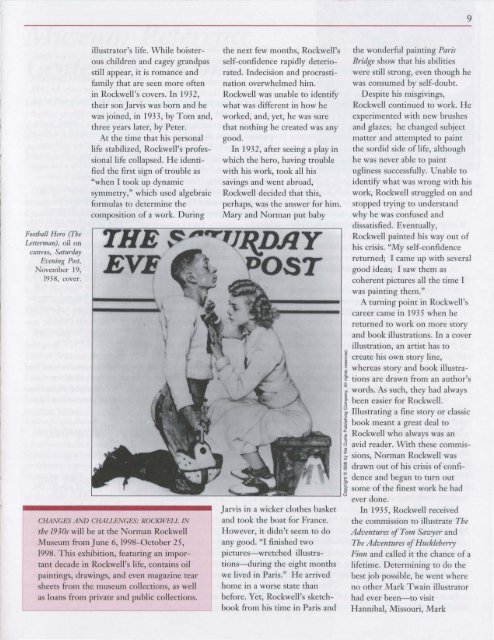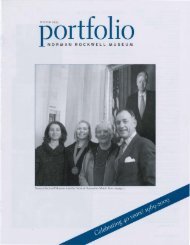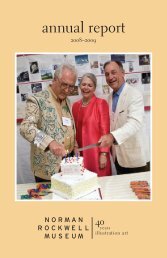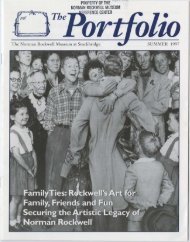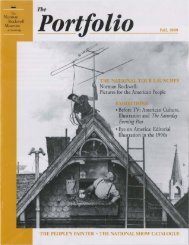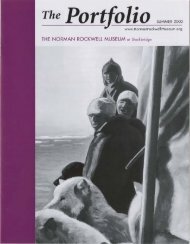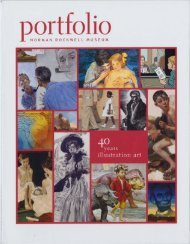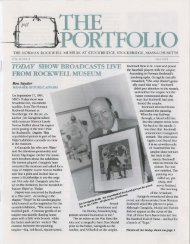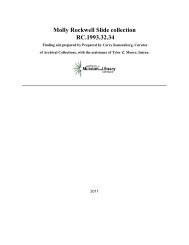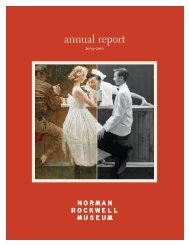Spring 1998 - Norman Rockwell Museum
Spring 1998 - Norman Rockwell Museum
Spring 1998 - Norman Rockwell Museum
Create successful ePaper yourself
Turn your PDF publications into a flip-book with our unique Google optimized e-Paper software.
9Football Hero (TheLetterman), oil oncanvas, SaturdayEvening Post,illustrator's life. While boisterouschildren and cagey grandpasstill appear, it is romance andfamily that are seen more oftenin <strong>Rockwell</strong>'s covers. In 1932,their son Jarvis was born and hewas joined, in 1933, by Tom and,three years later, by Peter.At the time that his personallife stabilized, <strong>Rockwell</strong>'s professionallifecollapsed. He identifiedthe first sign of trouble as"when I took up dynamicsymmetry," which used algebraicformulas to determine thecomposition of a work. DuringE~ Tr:-November 19, Y' ,.::1938, cover.CHANGES AND CHALLENGES: ROCKWELL INthe 1930s will be at the <strong>Norman</strong> <strong>Rockwell</strong><strong>Museum</strong> from June 6, <strong>1998</strong>-0ctober 25,<strong>1998</strong>. This exhibition, featuring an importantdecade in <strong>Rockwell</strong>'s life, contains oilpaintings, drawings, and even magazine tearsheets from the museum collections, as wellas loans from private and public collections.the next few months, <strong>Rockwell</strong>'sself-confidence rapidly deteriorated.Indecision and procrastinationoverwhelmed him.<strong>Rockwell</strong> was unable to identifywhat was different in how heworked, and, yet, he was surethat nothing he created was anygood.In 1932, after seeing a play inwhich the hero, having troublewith his work, took all hissavings and went abroad,<strong>Rockwell</strong> decided that this,perhaps, was the answer for him.Mary and <strong>Norman</strong> put babyyST------' uJarvis in a wicker clothes basketand took the boat for France.However, it didn't seem to doany good. "I finished twopictures-wretched illustrations-duringthe eight monthswe lived in Paris." He arrivedhome in a worse state thanbefore. Yet, <strong>Rockwell</strong>'s sketchbookfrom his time in Paris andthe wonderful painting ParisBridge show that his abilitieswere still strong, even though hewas consumed by self-doubt.Despite his misgivings,<strong>Rockwell</strong> continued to work. Heexperimented with new brushesand glazes; he changed subjectmatter and attempted to paintthe sordid side of life, althoughhe was never able to paintugliness successfully. Unable toidentify what was wrong with hiswork, <strong>Rockwell</strong> struggled on andstopped trying to understandwhy he was confused anddissatisfied. Eventually,<strong>Rockwell</strong> painted his way out ofhis crisis. "My self-confidencereturned; I came up with severalgood ideas; I saw them ascoherent pictures all the time Iwas painting them."A turning point in <strong>Rockwell</strong>'scareer came in 1935 when hereturned to work on more storyand book illustrations. In a coverillustration, an artist has to1 create his own story line,~ whereas story and book illustra~ tions are drawn from an author's~ words. As such, they had always~ been easier for <strong>Rockwell</strong>.~ Illustrating a fine story or classicj book meant a great deal to~ <strong>Rockwell</strong> who always was an8 avid reader. With these commis~ sions, <strong>Norman</strong> <strong>Rockwell</strong> was~ drawn out of his crisis of confi~ dence and began to turn out.~ some of the finest work he hadever done.In 1935, <strong>Rockwell</strong> receivedthe commission to illustrate TheAdventures of Tom Sawyer andThe Adventures of HuckleberryFinn and called it the chance of alifetime. Determining to do thebest job possible, he went whereno other Mark Twain illustratorhad ever been-to visitHannibal, Missouri, Mark


